CBA Bank's Failings: Responsibility, Risk, and Management
VerifiedAdded on 2023/05/28
|7
|1443
|248
Essay
AI Summary
This essay examines the Commonwealth Bank of Australia (CBA) and its various scandals, including money laundering, Ponzi schemes, and failures in financial planning and service delivery. It discusses arguments about the bank's responsibility for these failings, focusing on the criticism of its risk management model and the implementation of the three lines of defense. The essay presents counterarguments, highlighting the efficiency of the risk management model, the importance of collective accountability among staff, and the influence of financial regulations. It concludes that banks should focus on a holistic approach to business operations, encompassing risk management, regulatory frameworks, supervision, and employee accountability to ensure secure banking functions and a stable financial system.
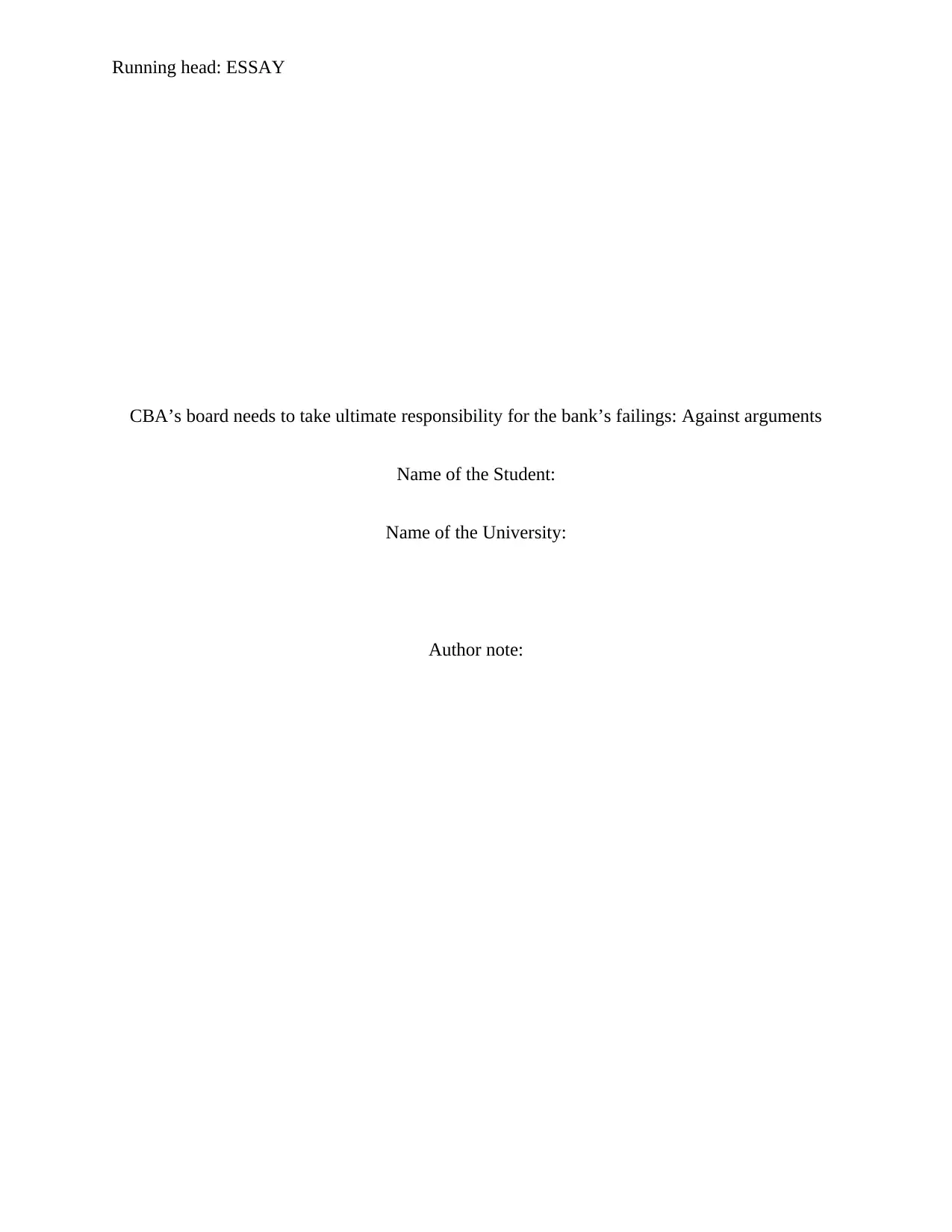
Running head: ESSAY
CBA’s board needs to take ultimate responsibility for the bank’s failings: Against arguments
Name of the Student:
Name of the University:
Author note:
CBA’s board needs to take ultimate responsibility for the bank’s failings: Against arguments
Name of the Student:
Name of the University:
Author note:
Paraphrase This Document
Need a fresh take? Get an instant paraphrase of this document with our AI Paraphraser
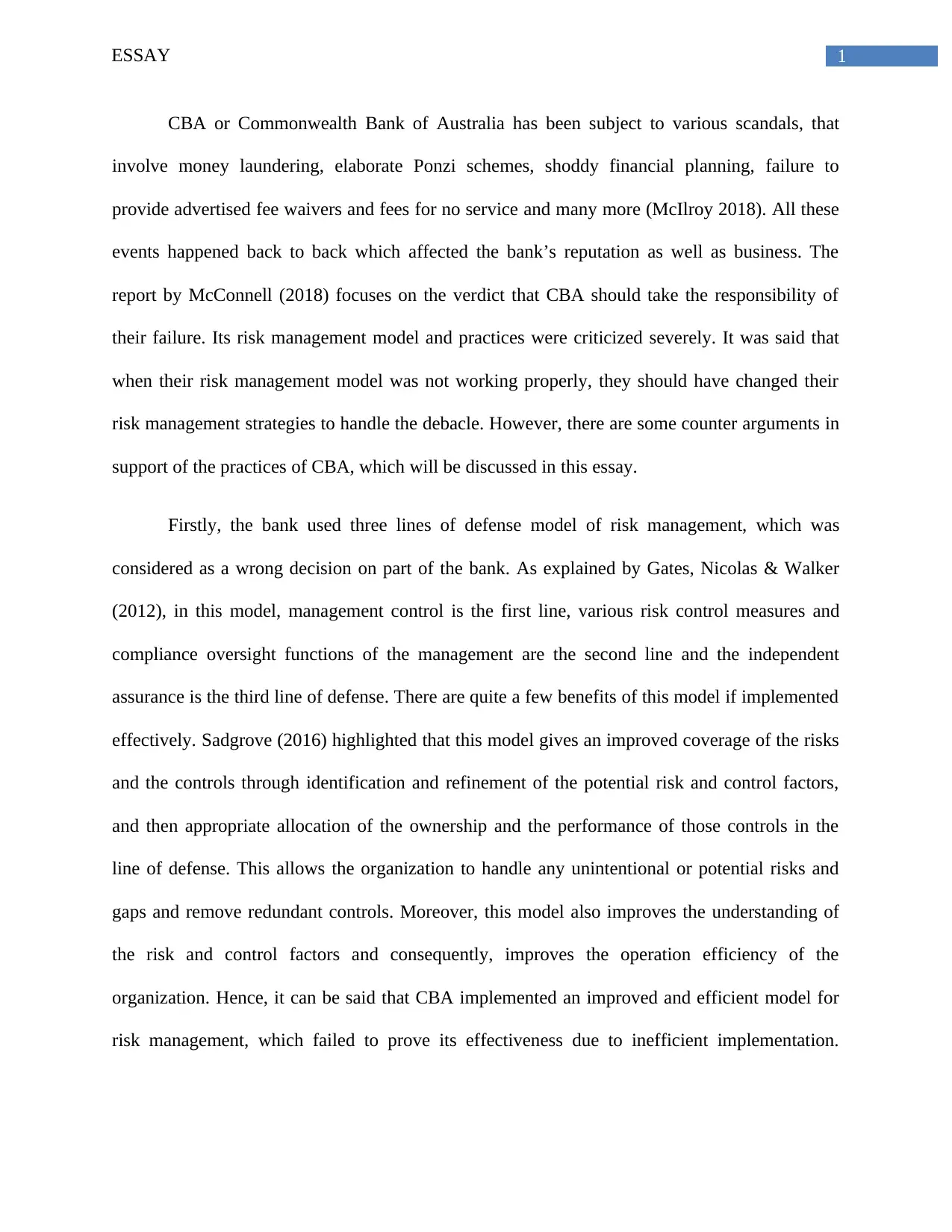
1ESSAY
CBA or Commonwealth Bank of Australia has been subject to various scandals, that
involve money laundering, elaborate Ponzi schemes, shoddy financial planning, failure to
provide advertised fee waivers and fees for no service and many more (McIlroy 2018). All these
events happened back to back which affected the bank’s reputation as well as business. The
report by McConnell (2018) focuses on the verdict that CBA should take the responsibility of
their failure. Its risk management model and practices were criticized severely. It was said that
when their risk management model was not working properly, they should have changed their
risk management strategies to handle the debacle. However, there are some counter arguments in
support of the practices of CBA, which will be discussed in this essay.
Firstly, the bank used three lines of defense model of risk management, which was
considered as a wrong decision on part of the bank. As explained by Gates, Nicolas & Walker
(2012), in this model, management control is the first line, various risk control measures and
compliance oversight functions of the management are the second line and the independent
assurance is the third line of defense. There are quite a few benefits of this model if implemented
effectively. Sadgrove (2016) highlighted that this model gives an improved coverage of the risks
and the controls through identification and refinement of the potential risk and control factors,
and then appropriate allocation of the ownership and the performance of those controls in the
line of defense. This allows the organization to handle any unintentional or potential risks and
gaps and remove redundant controls. Moreover, this model also improves the understanding of
the risk and control factors and consequently, improves the operation efficiency of the
organization. Hence, it can be said that CBA implemented an improved and efficient model for
risk management, which failed to prove its effectiveness due to inefficient implementation.
CBA or Commonwealth Bank of Australia has been subject to various scandals, that
involve money laundering, elaborate Ponzi schemes, shoddy financial planning, failure to
provide advertised fee waivers and fees for no service and many more (McIlroy 2018). All these
events happened back to back which affected the bank’s reputation as well as business. The
report by McConnell (2018) focuses on the verdict that CBA should take the responsibility of
their failure. Its risk management model and practices were criticized severely. It was said that
when their risk management model was not working properly, they should have changed their
risk management strategies to handle the debacle. However, there are some counter arguments in
support of the practices of CBA, which will be discussed in this essay.
Firstly, the bank used three lines of defense model of risk management, which was
considered as a wrong decision on part of the bank. As explained by Gates, Nicolas & Walker
(2012), in this model, management control is the first line, various risk control measures and
compliance oversight functions of the management are the second line and the independent
assurance is the third line of defense. There are quite a few benefits of this model if implemented
effectively. Sadgrove (2016) highlighted that this model gives an improved coverage of the risks
and the controls through identification and refinement of the potential risk and control factors,
and then appropriate allocation of the ownership and the performance of those controls in the
line of defense. This allows the organization to handle any unintentional or potential risks and
gaps and remove redundant controls. Moreover, this model also improves the understanding of
the risk and control factors and consequently, improves the operation efficiency of the
organization. Hence, it can be said that CBA implemented an improved and efficient model for
risk management, which failed to prove its effectiveness due to inefficient implementation.
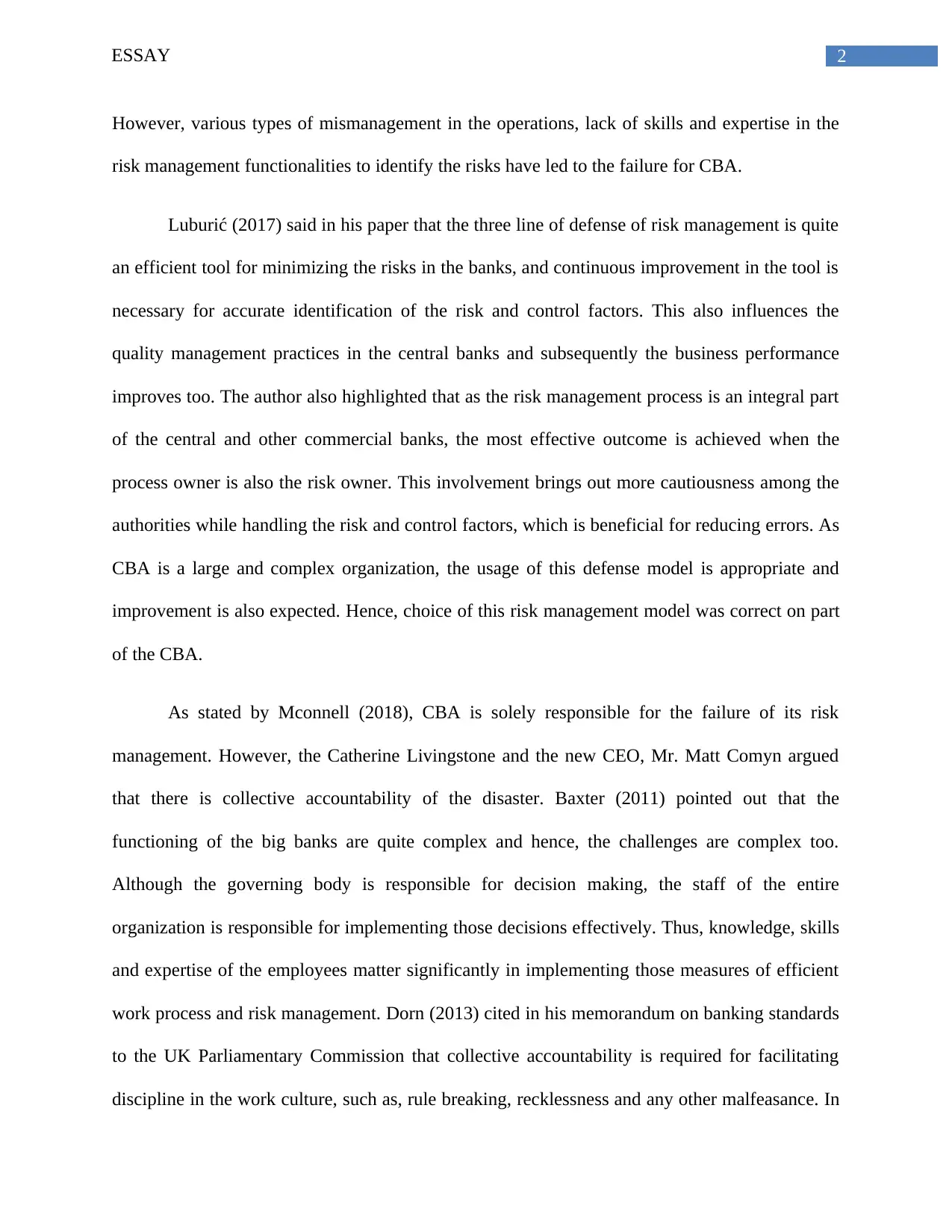
2ESSAY
However, various types of mismanagement in the operations, lack of skills and expertise in the
risk management functionalities to identify the risks have led to the failure for CBA.
Luburić (2017) said in his paper that the three line of defense of risk management is quite
an efficient tool for minimizing the risks in the banks, and continuous improvement in the tool is
necessary for accurate identification of the risk and control factors. This also influences the
quality management practices in the central banks and subsequently the business performance
improves too. The author also highlighted that as the risk management process is an integral part
of the central and other commercial banks, the most effective outcome is achieved when the
process owner is also the risk owner. This involvement brings out more cautiousness among the
authorities while handling the risk and control factors, which is beneficial for reducing errors. As
CBA is a large and complex organization, the usage of this defense model is appropriate and
improvement is also expected. Hence, choice of this risk management model was correct on part
of the CBA.
As stated by Mconnell (2018), CBA is solely responsible for the failure of its risk
management. However, the Catherine Livingstone and the new CEO, Mr. Matt Comyn argued
that there is collective accountability of the disaster. Baxter (2011) pointed out that the
functioning of the big banks are quite complex and hence, the challenges are complex too.
Although the governing body is responsible for decision making, the staff of the entire
organization is responsible for implementing those decisions effectively. Thus, knowledge, skills
and expertise of the employees matter significantly in implementing those measures of efficient
work process and risk management. Dorn (2013) cited in his memorandum on banking standards
to the UK Parliamentary Commission that collective accountability is required for facilitating
discipline in the work culture, such as, rule breaking, recklessness and any other malfeasance. In
However, various types of mismanagement in the operations, lack of skills and expertise in the
risk management functionalities to identify the risks have led to the failure for CBA.
Luburić (2017) said in his paper that the three line of defense of risk management is quite
an efficient tool for minimizing the risks in the banks, and continuous improvement in the tool is
necessary for accurate identification of the risk and control factors. This also influences the
quality management practices in the central banks and subsequently the business performance
improves too. The author also highlighted that as the risk management process is an integral part
of the central and other commercial banks, the most effective outcome is achieved when the
process owner is also the risk owner. This involvement brings out more cautiousness among the
authorities while handling the risk and control factors, which is beneficial for reducing errors. As
CBA is a large and complex organization, the usage of this defense model is appropriate and
improvement is also expected. Hence, choice of this risk management model was correct on part
of the CBA.
As stated by Mconnell (2018), CBA is solely responsible for the failure of its risk
management. However, the Catherine Livingstone and the new CEO, Mr. Matt Comyn argued
that there is collective accountability of the disaster. Baxter (2011) pointed out that the
functioning of the big banks are quite complex and hence, the challenges are complex too.
Although the governing body is responsible for decision making, the staff of the entire
organization is responsible for implementing those decisions effectively. Thus, knowledge, skills
and expertise of the employees matter significantly in implementing those measures of efficient
work process and risk management. Dorn (2013) cited in his memorandum on banking standards
to the UK Parliamentary Commission that collective accountability is required for facilitating
discipline in the work culture, such as, rule breaking, recklessness and any other malfeasance. In
⊘ This is a preview!⊘
Do you want full access?
Subscribe today to unlock all pages.

Trusted by 1+ million students worldwide
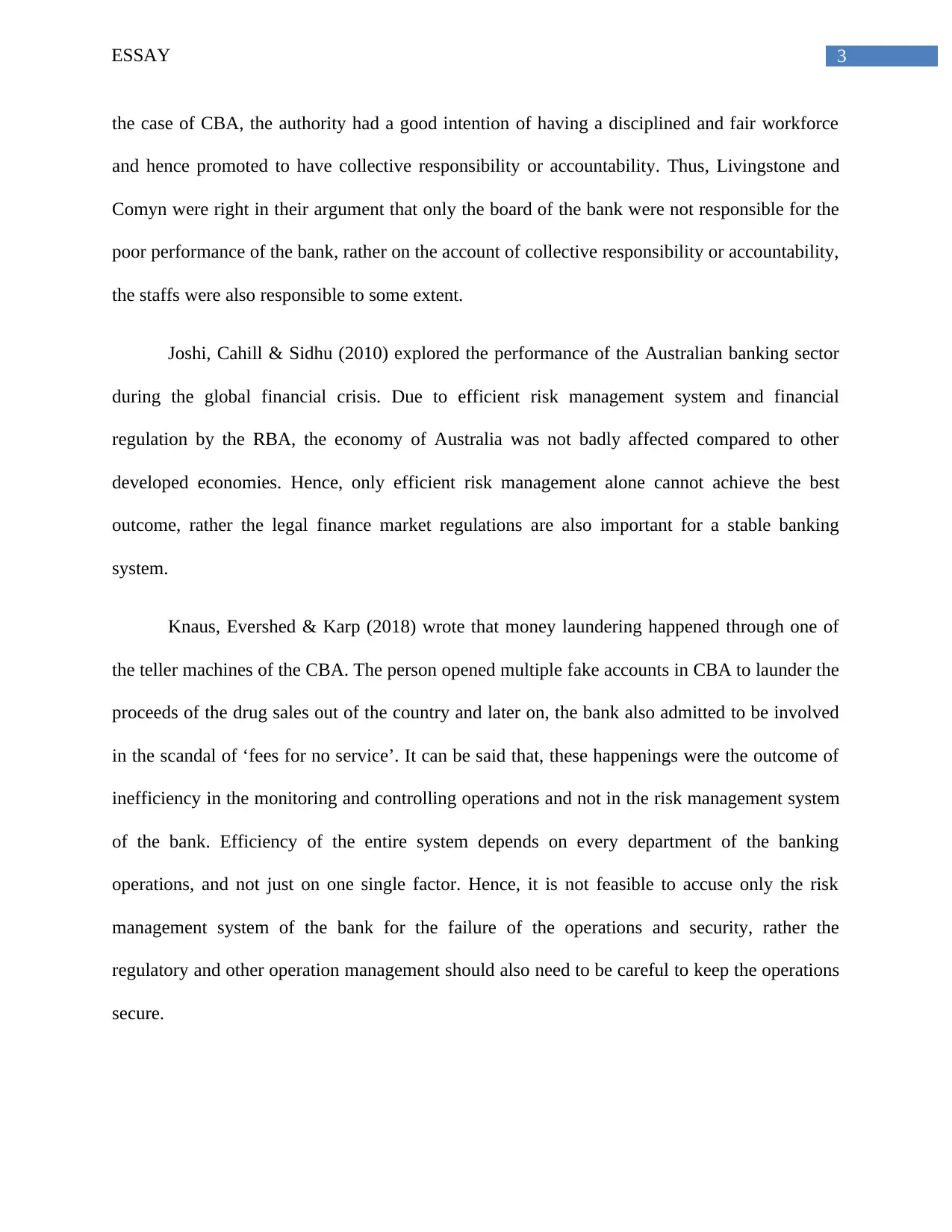
3ESSAY
the case of CBA, the authority had a good intention of having a disciplined and fair workforce
and hence promoted to have collective responsibility or accountability. Thus, Livingstone and
Comyn were right in their argument that only the board of the bank were not responsible for the
poor performance of the bank, rather on the account of collective responsibility or accountability,
the staffs were also responsible to some extent.
Joshi, Cahill & Sidhu (2010) explored the performance of the Australian banking sector
during the global financial crisis. Due to efficient risk management system and financial
regulation by the RBA, the economy of Australia was not badly affected compared to other
developed economies. Hence, only efficient risk management alone cannot achieve the best
outcome, rather the legal finance market regulations are also important for a stable banking
system.
Knaus, Evershed & Karp (2018) wrote that money laundering happened through one of
the teller machines of the CBA. The person opened multiple fake accounts in CBA to launder the
proceeds of the drug sales out of the country and later on, the bank also admitted to be involved
in the scandal of ‘fees for no service’. It can be said that, these happenings were the outcome of
inefficiency in the monitoring and controlling operations and not in the risk management system
of the bank. Efficiency of the entire system depends on every department of the banking
operations, and not just on one single factor. Hence, it is not feasible to accuse only the risk
management system of the bank for the failure of the operations and security, rather the
regulatory and other operation management should also need to be careful to keep the operations
secure.
the case of CBA, the authority had a good intention of having a disciplined and fair workforce
and hence promoted to have collective responsibility or accountability. Thus, Livingstone and
Comyn were right in their argument that only the board of the bank were not responsible for the
poor performance of the bank, rather on the account of collective responsibility or accountability,
the staffs were also responsible to some extent.
Joshi, Cahill & Sidhu (2010) explored the performance of the Australian banking sector
during the global financial crisis. Due to efficient risk management system and financial
regulation by the RBA, the economy of Australia was not badly affected compared to other
developed economies. Hence, only efficient risk management alone cannot achieve the best
outcome, rather the legal finance market regulations are also important for a stable banking
system.
Knaus, Evershed & Karp (2018) wrote that money laundering happened through one of
the teller machines of the CBA. The person opened multiple fake accounts in CBA to launder the
proceeds of the drug sales out of the country and later on, the bank also admitted to be involved
in the scandal of ‘fees for no service’. It can be said that, these happenings were the outcome of
inefficiency in the monitoring and controlling operations and not in the risk management system
of the bank. Efficiency of the entire system depends on every department of the banking
operations, and not just on one single factor. Hence, it is not feasible to accuse only the risk
management system of the bank for the failure of the operations and security, rather the
regulatory and other operation management should also need to be careful to keep the operations
secure.
Paraphrase This Document
Need a fresh take? Get an instant paraphrase of this document with our AI Paraphraser
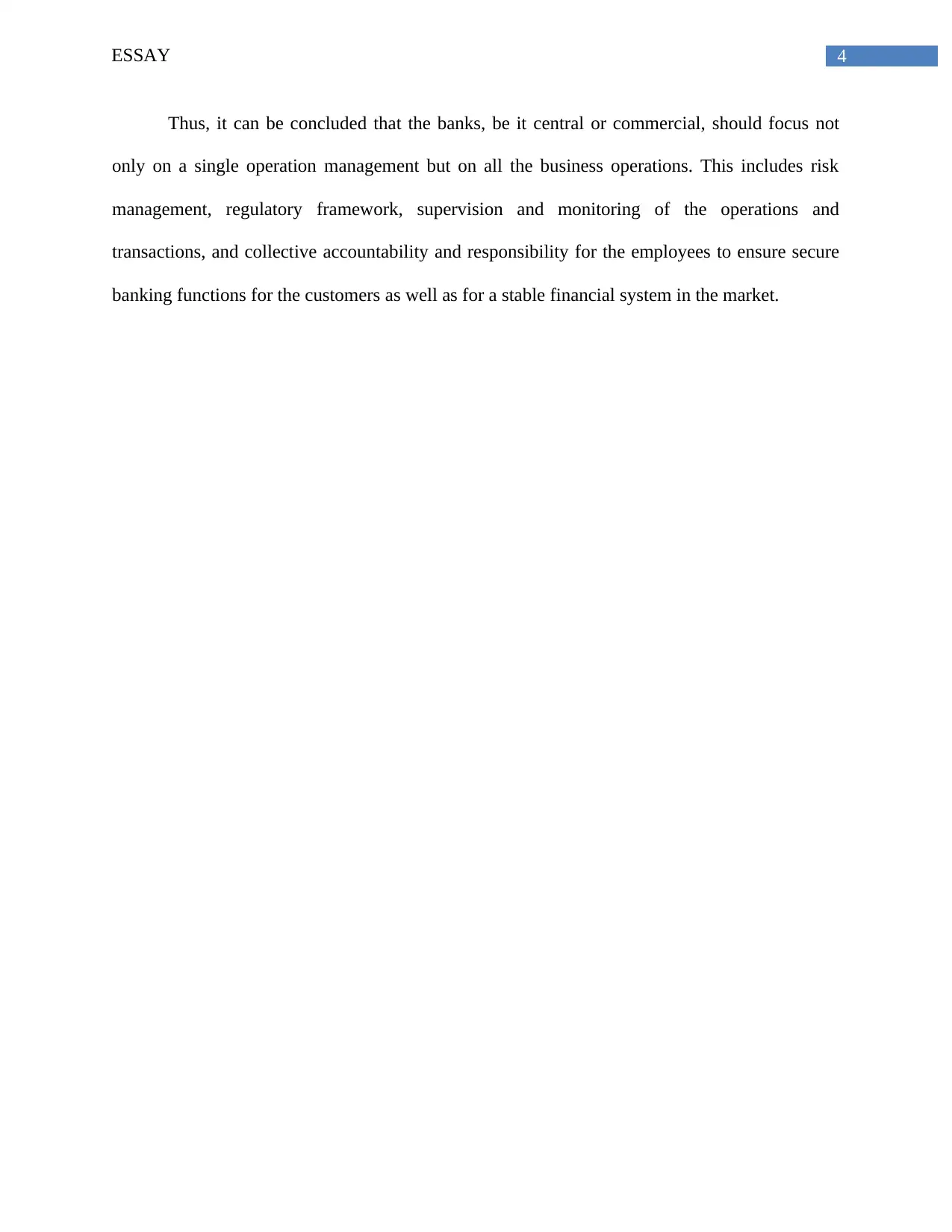
4ESSAY
Thus, it can be concluded that the banks, be it central or commercial, should focus not
only on a single operation management but on all the business operations. This includes risk
management, regulatory framework, supervision and monitoring of the operations and
transactions, and collective accountability and responsibility for the employees to ensure secure
banking functions for the customers as well as for a stable financial system in the market.
Thus, it can be concluded that the banks, be it central or commercial, should focus not
only on a single operation management but on all the business operations. This includes risk
management, regulatory framework, supervision and monitoring of the operations and
transactions, and collective accountability and responsibility for the employees to ensure secure
banking functions for the customers as well as for a stable financial system in the market.
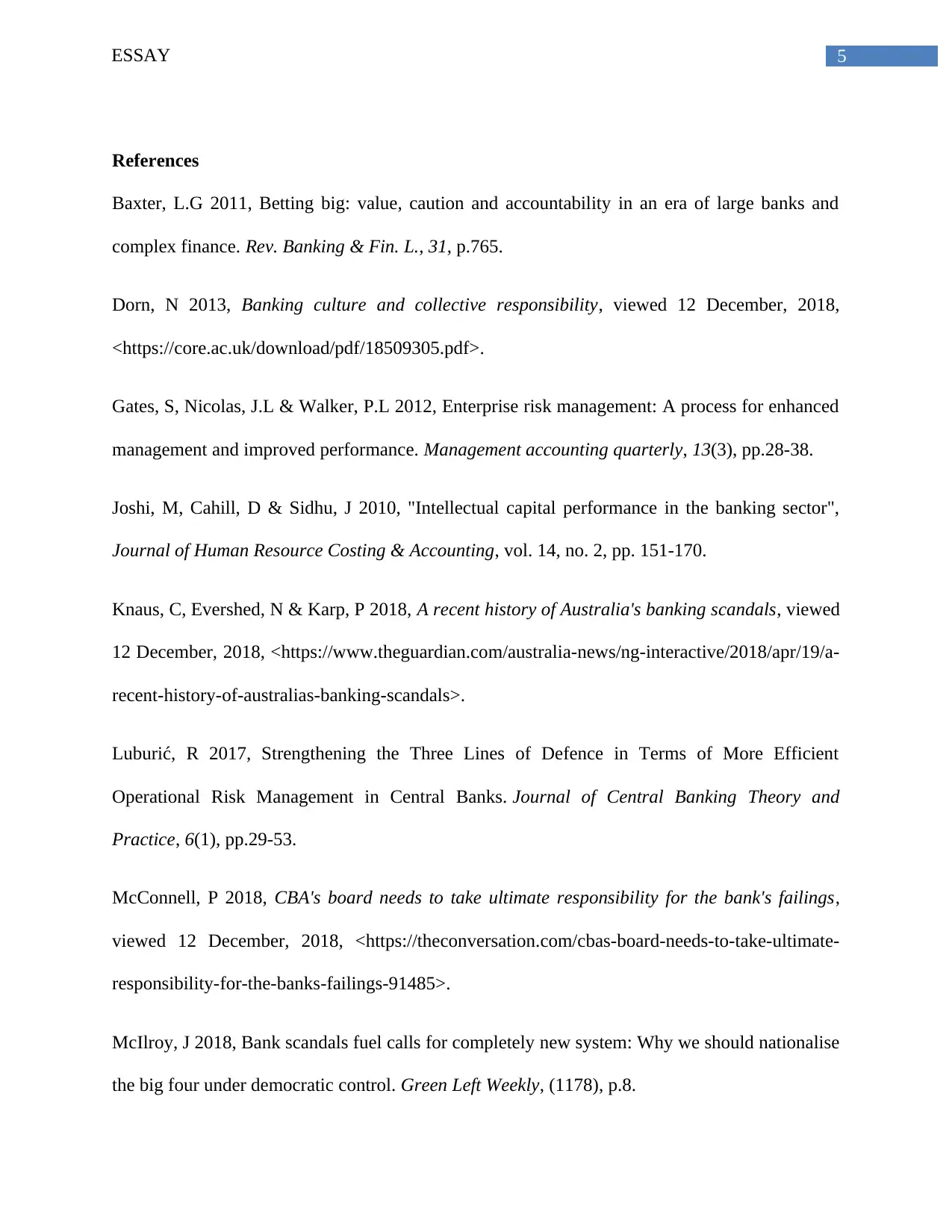
5ESSAY
References
Baxter, L.G 2011, Betting big: value, caution and accountability in an era of large banks and
complex finance. Rev. Banking & Fin. L., 31, p.765.
Dorn, N 2013, Banking culture and collective responsibility, viewed 12 December, 2018,
<https://core.ac.uk/download/pdf/18509305.pdf>.
Gates, S, Nicolas, J.L & Walker, P.L 2012, Enterprise risk management: A process for enhanced
management and improved performance. Management accounting quarterly, 13(3), pp.28-38.
Joshi, M, Cahill, D & Sidhu, J 2010, "Intellectual capital performance in the banking sector",
Journal of Human Resource Costing & Accounting, vol. 14, no. 2, pp. 151-170.
Knaus, C, Evershed, N & Karp, P 2018, A recent history of Australia's banking scandals, viewed
12 December, 2018, <https://www.theguardian.com/australia-news/ng-interactive/2018/apr/19/a-
recent-history-of-australias-banking-scandals>.
Luburić, R 2017, Strengthening the Three Lines of Defence in Terms of More Efficient
Operational Risk Management in Central Banks. Journal of Central Banking Theory and
Practice, 6(1), pp.29-53.
McConnell, P 2018, CBA's board needs to take ultimate responsibility for the bank's failings,
viewed 12 December, 2018, <https://theconversation.com/cbas-board-needs-to-take-ultimate-
responsibility-for-the-banks-failings-91485>.
McIlroy, J 2018, Bank scandals fuel calls for completely new system: Why we should nationalise
the big four under democratic control. Green Left Weekly, (1178), p.8.
References
Baxter, L.G 2011, Betting big: value, caution and accountability in an era of large banks and
complex finance. Rev. Banking & Fin. L., 31, p.765.
Dorn, N 2013, Banking culture and collective responsibility, viewed 12 December, 2018,
<https://core.ac.uk/download/pdf/18509305.pdf>.
Gates, S, Nicolas, J.L & Walker, P.L 2012, Enterprise risk management: A process for enhanced
management and improved performance. Management accounting quarterly, 13(3), pp.28-38.
Joshi, M, Cahill, D & Sidhu, J 2010, "Intellectual capital performance in the banking sector",
Journal of Human Resource Costing & Accounting, vol. 14, no. 2, pp. 151-170.
Knaus, C, Evershed, N & Karp, P 2018, A recent history of Australia's banking scandals, viewed
12 December, 2018, <https://www.theguardian.com/australia-news/ng-interactive/2018/apr/19/a-
recent-history-of-australias-banking-scandals>.
Luburić, R 2017, Strengthening the Three Lines of Defence in Terms of More Efficient
Operational Risk Management in Central Banks. Journal of Central Banking Theory and
Practice, 6(1), pp.29-53.
McConnell, P 2018, CBA's board needs to take ultimate responsibility for the bank's failings,
viewed 12 December, 2018, <https://theconversation.com/cbas-board-needs-to-take-ultimate-
responsibility-for-the-banks-failings-91485>.
McIlroy, J 2018, Bank scandals fuel calls for completely new system: Why we should nationalise
the big four under democratic control. Green Left Weekly, (1178), p.8.
⊘ This is a preview!⊘
Do you want full access?
Subscribe today to unlock all pages.

Trusted by 1+ million students worldwide

6ESSAY
Sadgrove, K 2016, The complete guide to business risk management. Routledge.
Sadgrove, K 2016, The complete guide to business risk management. Routledge.
1 out of 7
Your All-in-One AI-Powered Toolkit for Academic Success.
+13062052269
info@desklib.com
Available 24*7 on WhatsApp / Email
![[object Object]](/_next/static/media/star-bottom.7253800d.svg)
Unlock your academic potential
Copyright © 2020–2025 A2Z Services. All Rights Reserved. Developed and managed by ZUCOL.

